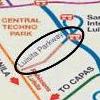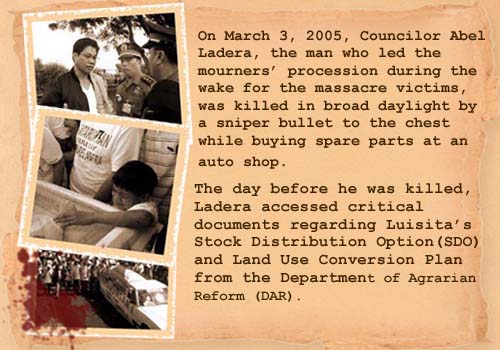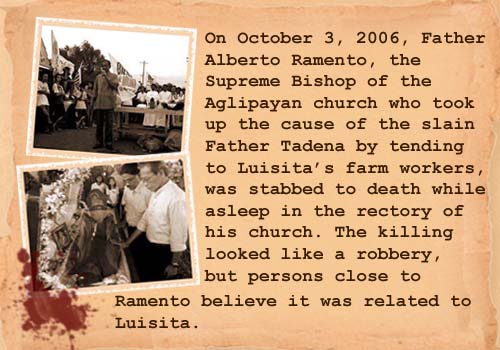Filtered by: Topstories
News
After Luisita massacre, more killings linked to protest
By STEPHANIE DYCHIU
Fourth of a series (Part 4 of this special report on Hacienda Luisita begins in December 2004, the month after the Luisita massacre. Recognizing that Luisita will be a major campaign issue this year and has divided even presidential candidate Sen. Noynoy Aquino’s own allies, GMANews.TV has been researching the issues surrounding the Cojuangco-owned hacienda for the past three months. Editor-in-chief Howie Severino has been working closely with the author in producing this report.) 

 On January 5, 2005 (or nearly two months after the Luisita massacre), some 20 picketers were manning the picket point at the west gate of Las Haciendas subdivision inside Hacienda Luisita. According to Police Chief Superintendent Angelo Sunglao of the Tarlac City PNP, at about 10:40 pm, a Nissan Patrol drove up to the gate from inside the subdivision, and an altercation ensued between the picketers and the men on board the vehicle. Continue reading Sen. Aquino declined through his staff to be interviewed. Questions sent to him about the above incident went unanswered. But GMANews.TV combed the web and newspaper archives for any statements he made about the incidents in this series of reports. His staff also emailed to GMANews.TV several statements of Sen. Aquino on other Luisita-related issues. These statements were included below and other parts of the series. Noynoy denies link to SCTEx project In November 2009, an investigation into the SCTEx project was launched in Congress by Aquino’s political rivals. Cavite Rep. Crispin Remulla, an ally of Senator Manny Villar, accused Aquino of lobbying for the Luisita interchange of the SCTEx, saying the government paid Hacienda Luisita, Inc (HLI) an inflated amount of P83 million for the road right of way, and assumed the cost of building a P170-million interchange to connect the Central Techno Park inside his family’s hacienda to the SCTEx.
On January 5, 2005 (or nearly two months after the Luisita massacre), some 20 picketers were manning the picket point at the west gate of Las Haciendas subdivision inside Hacienda Luisita. According to Police Chief Superintendent Angelo Sunglao of the Tarlac City PNP, at about 10:40 pm, a Nissan Patrol drove up to the gate from inside the subdivision, and an altercation ensued between the picketers and the men on board the vehicle. Continue reading Sen. Aquino declined through his staff to be interviewed. Questions sent to him about the above incident went unanswered. But GMANews.TV combed the web and newspaper archives for any statements he made about the incidents in this series of reports. His staff also emailed to GMANews.TV several statements of Sen. Aquino on other Luisita-related issues. These statements were included below and other parts of the series. Noynoy denies link to SCTEx project In November 2009, an investigation into the SCTEx project was launched in Congress by Aquino’s political rivals. Cavite Rep. Crispin Remulla, an ally of Senator Manny Villar, accused Aquino of lobbying for the Luisita interchange of the SCTEx, saying the government paid Hacienda Luisita, Inc (HLI) an inflated amount of P83 million for the road right of way, and assumed the cost of building a P170-million interchange to connect the Central Techno Park inside his family’s hacienda to the SCTEx.  The 94-kilometer Subic-Clark-Tarlac Expressway (SCTEx) is presently the longest highway in the Philippines. It connects the Subic Bay Freeport, the Clark Freeport, and Tarlac City. The Bases Conversion Development Authority (BCDA) was the government arm that oversaw the implementation of the project. According to the BCDA, 85% of the P27 billion cost to build the SCTEx was financed through funds borrowed by the government from the Japan Bank for International Cooperation (JBIC). Continue reading In a November 12, 2009 report of GMANews.TV, Aquino denied he had anything to do with the project. He attributed the reports linking him to the SCTEx issue to character assassination because he was leading surveys for the presidential elections. Loveland’s statements about Aquino and the superhighway, however, were recorded five years ago, before anyone had an inkling Aquino would run for president. City councilor murdered On March 3, 2005, Councilor Abel Ladera, the man who led the mourners’ procession during the wake for the massacre victims, was killed in broad daylight by a sniper bullet to the chest while buying spare parts at an auto shop. Ladera was a former sugar mill worker who grew up in one of the barangays of Hacienda Luisita. He became an engineer, then a city councilor. Ladera was at the forefront of the fight against land conversion. He was also scheduled to make a presentation on March 8, 2005 to an assembly of barangay captains to disprove the claim of the Philippine National Police (PNP) that the violent dispersal on November 16, 2004 occurred because shots were fired from the ranks of the strikers.
The 94-kilometer Subic-Clark-Tarlac Expressway (SCTEx) is presently the longest highway in the Philippines. It connects the Subic Bay Freeport, the Clark Freeport, and Tarlac City. The Bases Conversion Development Authority (BCDA) was the government arm that oversaw the implementation of the project. According to the BCDA, 85% of the P27 billion cost to build the SCTEx was financed through funds borrowed by the government from the Japan Bank for International Cooperation (JBIC). Continue reading In a November 12, 2009 report of GMANews.TV, Aquino denied he had anything to do with the project. He attributed the reports linking him to the SCTEx issue to character assassination because he was leading surveys for the presidential elections. Loveland’s statements about Aquino and the superhighway, however, were recorded five years ago, before anyone had an inkling Aquino would run for president. City councilor murdered On March 3, 2005, Councilor Abel Ladera, the man who led the mourners’ procession during the wake for the massacre victims, was killed in broad daylight by a sniper bullet to the chest while buying spare parts at an auto shop. Ladera was a former sugar mill worker who grew up in one of the barangays of Hacienda Luisita. He became an engineer, then a city councilor. Ladera was at the forefront of the fight against land conversion. He was also scheduled to make a presentation on March 8, 2005 to an assembly of barangay captains to disprove the claim of the Philippine National Police (PNP) that the violent dispersal on November 16, 2004 occurred because shots were fired from the ranks of the strikers. 
 Tarlac City Councilor Abel Ladera, who was murdered on March 3, 2005, was a former sugar mill worker who grew up in one of the barangays of Hacienda Luisita. He became an engineer, then a city councilor. Because of his background, Ladera was very active in issues involving human rights and labor and employment. He played a key role in negotiations between the management of Hacienda Luisita and the two unions, ULWU (United Luisita Workers’ Union) and CATLU (Central Azucarera de Tarlac Labor Union). Ladera was also at the forefront of the fight against land conversion. Continue reading Priest and peasant leaders shot dead On March 13, 2005, Father William Tadena, an Aglipayan priest who had mobilized his parish to regularly donate rice and groceries to the workers at the picket line before saying a weekly mass for them, was shot dead in his owner-type jeep on the provincial highway in La Paz, Tarlac while on his way to his next mass. On March 17, 2005, “Tatang" Ben Concepcion, a 67-year-old peasant leader of party-list group Anakpawis in Pampanga, who supported the strikers in Luisita despite his old age and lung and heart ailments, was shot dead in his daughter’s house in Angeles City (40 minutes from Tarlac City). He had just been released from the hospital and was recuperating in his daughter’s house. On October 15, 2005, Flor Collantes, the secretary general of party-list group Bayan Muna in Tarlac, was killed while cleaning fish in his carinderia. Union president killed On October 25, 2005, Ric Ramos, the president of the union of the sugar mill workers (Central Azucarera de Tarlac Labor Union or CATLU), was killed by an M-14 sniper bullet in his hut where he was celebrating with some companions. Hours before he was killed, Ramos finished distributing cash benefits to the sugar mill workers after he successfully got the sheriff to confiscate sugar from management a few days before, says Lito Bais, current acting president of the union of the farm workers (United Luisita Workers Union or ULWU). According to Bais, management had been claiming it had no money to pay wages and benefits due to the workers. “Pumunta si Ric Ramos sa DOLE (Department of Labor and Employment), pina-sheriff niya ang bodega ng mga Cojuangco kung may mga asukal pa. Nakita puno ng asukal. Nagkasundo na ibebenta ng DOLE ang asukal, pagkatpos ibibigay ang pera sa mga manggagawa (Ric Ramos went to the Department of Labor. He asked the sheriff to inspect the warehouse of the Cojuangcos. It was full of sugar. An agreement was made for the Department of Labor to sell the sugar, with the proceeds to be given to the workers)."
Tarlac City Councilor Abel Ladera, who was murdered on March 3, 2005, was a former sugar mill worker who grew up in one of the barangays of Hacienda Luisita. He became an engineer, then a city councilor. Because of his background, Ladera was very active in issues involving human rights and labor and employment. He played a key role in negotiations between the management of Hacienda Luisita and the two unions, ULWU (United Luisita Workers’ Union) and CATLU (Central Azucarera de Tarlac Labor Union). Ladera was also at the forefront of the fight against land conversion. Continue reading Priest and peasant leaders shot dead On March 13, 2005, Father William Tadena, an Aglipayan priest who had mobilized his parish to regularly donate rice and groceries to the workers at the picket line before saying a weekly mass for them, was shot dead in his owner-type jeep on the provincial highway in La Paz, Tarlac while on his way to his next mass. On March 17, 2005, “Tatang" Ben Concepcion, a 67-year-old peasant leader of party-list group Anakpawis in Pampanga, who supported the strikers in Luisita despite his old age and lung and heart ailments, was shot dead in his daughter’s house in Angeles City (40 minutes from Tarlac City). He had just been released from the hospital and was recuperating in his daughter’s house. On October 15, 2005, Flor Collantes, the secretary general of party-list group Bayan Muna in Tarlac, was killed while cleaning fish in his carinderia. Union president killed On October 25, 2005, Ric Ramos, the president of the union of the sugar mill workers (Central Azucarera de Tarlac Labor Union or CATLU), was killed by an M-14 sniper bullet in his hut where he was celebrating with some companions. Hours before he was killed, Ramos finished distributing cash benefits to the sugar mill workers after he successfully got the sheriff to confiscate sugar from management a few days before, says Lito Bais, current acting president of the union of the farm workers (United Luisita Workers Union or ULWU). According to Bais, management had been claiming it had no money to pay wages and benefits due to the workers. “Pumunta si Ric Ramos sa DOLE (Department of Labor and Employment), pina-sheriff niya ang bodega ng mga Cojuangco kung may mga asukal pa. Nakita puno ng asukal. Nagkasundo na ibebenta ng DOLE ang asukal, pagkatpos ibibigay ang pera sa mga manggagawa (Ric Ramos went to the Department of Labor. He asked the sheriff to inspect the warehouse of the Cojuangcos. It was full of sugar. An agreement was made for the Department of Labor to sell the sugar, with the proceeds to be given to the workers)." 
 On October 27, 2005, two days after the murder of Ramos, Rep. Noynoy Aquino’s statement was reported in the Philippine Star: “I am shocked. My mother even more so. Ricardo Ramos has always treated me fairly, even at the height of the Luisita problem. The timing was also shocking, at a time when an agreement had been reached with two unions of the hacienda. In fact, Ramos was at a celebration when he was killed. It had been close to two years since the strike, and he was celebrating the end of a problem." In the same report, the PNP said leftists were suspected of killing Ramos because he was cooperating with management. Continue reading Luisita killings in impeachment complaint The murders of Marcelino Beltran, Abel Ladera, Father William Tadena, Ben Concepcion, Flor Collantes, and Ric Ramos, as well as the shooting of George Loveland and Ernesto Ramos “by unidentified bodyguards of Rep. Benigno ‘Noynoy’ Aquino", were part of the list of human rights violations described in the impeachment complaint filed against President Gloria Arroyo in Congress in October 2008. In the complaint, Arroyo was accused of turning a blind eye to the Hacienda Luisita killings “in collusion with the hacienda owners". (Arroyo and the Cojuangco-Aquinos were close allies until the latter half of 2005.) “The Cojuangco-Aquino family, in conspiracy with the military, the police, the paramilitary groups such as the Civilian Armed Forces Geographical Units (CAFGU), and other hired agents/gunmen, has continued to harass, threaten and violate the rights of the hacienda people," the impeachment complaint stated. “Hello Garci" and Luisita The year 2005 was a crucial turning point in the farm workers’ struggle in Luisita, and once again demonstrated the transcendental link between the hacienda and Malacañang that has been manifesting since the time of President Ramon Magsaysay. Under pressure from public outrage over the November 2004 massacre, the Arroyo administration, through the Department of Agrarian Reform (DAR), formed Task Force Stock Distribution on November 25, 2004 to study the causes of the workers’ strike. The Task Force was later renamed Task Force Luisita. In March 2005, teams were sent by the DAR to Luisita’s 10 barangays to investigate the SDO. Three months later, while the investigation was ongoing, “Hello Garci" hit the country—and possibly turned the tide in Luisita.
On October 27, 2005, two days after the murder of Ramos, Rep. Noynoy Aquino’s statement was reported in the Philippine Star: “I am shocked. My mother even more so. Ricardo Ramos has always treated me fairly, even at the height of the Luisita problem. The timing was also shocking, at a time when an agreement had been reached with two unions of the hacienda. In fact, Ramos was at a celebration when he was killed. It had been close to two years since the strike, and he was celebrating the end of a problem." In the same report, the PNP said leftists were suspected of killing Ramos because he was cooperating with management. Continue reading Luisita killings in impeachment complaint The murders of Marcelino Beltran, Abel Ladera, Father William Tadena, Ben Concepcion, Flor Collantes, and Ric Ramos, as well as the shooting of George Loveland and Ernesto Ramos “by unidentified bodyguards of Rep. Benigno ‘Noynoy’ Aquino", were part of the list of human rights violations described in the impeachment complaint filed against President Gloria Arroyo in Congress in October 2008. In the complaint, Arroyo was accused of turning a blind eye to the Hacienda Luisita killings “in collusion with the hacienda owners". (Arroyo and the Cojuangco-Aquinos were close allies until the latter half of 2005.) “The Cojuangco-Aquino family, in conspiracy with the military, the police, the paramilitary groups such as the Civilian Armed Forces Geographical Units (CAFGU), and other hired agents/gunmen, has continued to harass, threaten and violate the rights of the hacienda people," the impeachment complaint stated. “Hello Garci" and Luisita The year 2005 was a crucial turning point in the farm workers’ struggle in Luisita, and once again demonstrated the transcendental link between the hacienda and Malacañang that has been manifesting since the time of President Ramon Magsaysay. Under pressure from public outrage over the November 2004 massacre, the Arroyo administration, through the Department of Agrarian Reform (DAR), formed Task Force Stock Distribution on November 25, 2004 to study the causes of the workers’ strike. The Task Force was later renamed Task Force Luisita. In March 2005, teams were sent by the DAR to Luisita’s 10 barangays to investigate the SDO. Three months later, while the investigation was ongoing, “Hello Garci" hit the country—and possibly turned the tide in Luisita. 




 Part 1: Hacienda Luisita's past haunts Noynoy's future The issues surrounding Hacienda Luisita are being seen as the first real test of character of presidential hopeful Noynoy Cojuangco Aquino, whose family has owned the land since 1958. Our research shows that the problem began when government lenders obliged the Cojuangcos to distribute the land to small farmers by 1967, a deadline that came and went.
Part 1: Hacienda Luisita's past haunts Noynoy's future The issues surrounding Hacienda Luisita are being seen as the first real test of character of presidential hopeful Noynoy Cojuangco Aquino, whose family has owned the land since 1958. Our research shows that the problem began when government lenders obliged the Cojuangcos to distribute the land to small farmers by 1967, a deadline that came and went.  Part 2: Cory’s land reform legacy to test Noynoy’s political will There is a haunting resemblance between Senator Aquino’s “Hindi Ka Nag-Iisa" music video and a real-life torchlit march of Hacienda Luisita’s workers days before the November 16, 2004 massacre. What could be worth all the blood that has been spilled?
Part 2: Cory’s land reform legacy to test Noynoy’s political will There is a haunting resemblance between Senator Aquino’s “Hindi Ka Nag-Iisa" music video and a real-life torchlit march of Hacienda Luisita’s workers days before the November 16, 2004 massacre. What could be worth all the blood that has been spilled?  Part 3: How a worker's strike became the Luisita massacre As Sen. Noynoy Aquino campaigns for the presidency, new attention has been focused on events of five years ago when labor strife on his family's sugar estate left seven dead. This is the third of a series that examines the tortured history of Hacienda Luisita, an issue that would face another Aquino administration.
Part 3: How a worker's strike became the Luisita massacre As Sen. Noynoy Aquino campaigns for the presidency, new attention has been focused on events of five years ago when labor strife on his family's sugar estate left seven dead. This is the third of a series that examines the tortured history of Hacienda Luisita, an issue that would face another Aquino administration.  Part 5: Win or lose, Noynoy has to face Luisita deadlock Since 2006, Hacienda Luisita and its farmer-beneficiaries have been locked in a stalemate after the Supreme Court temporarily stopped the implementation of a government order revoking the stock distribution option of the hacienda. In the fifth and last part of this series, presidential candidate Noynoy Aquino speaks on the range of Luisita-related issues that could hound his administraiton if he wins.
Part 5: Win or lose, Noynoy has to face Luisita deadlock Since 2006, Hacienda Luisita and its farmer-beneficiaries have been locked in a stalemate after the Supreme Court temporarily stopped the implementation of a government order revoking the stock distribution option of the hacienda. In the fifth and last part of this series, presidential candidate Noynoy Aquino speaks on the range of Luisita-related issues that could hound his administraiton if he wins.


LOVELAND: Sinasabi niya po yung hinihingi daw po niyang pabor yung sa superhighway na hinihingi niya . . . (He was talking about a favor for the superhighway that he was asking for . . .) SENATOR OSMEÑA: Ano tungkol sa superhighway (What about the superhighway)? LOVELAND: Project niya daw po, sir . . . (He said it was his project . . . ) OSMEÑA: Ano ang hiningi ni Congressman Aquino (What did Congressman Aquino ask for)? LOVELAND: Yung ipatupad, sir, yung kuwan expressway, sir (To let it happen, sir, the expressway, sir). OSMEÑA: Yung galing sa Subic at Clark (The one from Subic and Clark)?
The January 5, 2005 Shooting at the West Gate of Las Haciendas Subdivision

The SCTEX Issue


The murder of Abel Ladera


Another version of the story






The farmers liable for debt?
To illustrate how HLI’s debt complicates land distribution in Hacienda Luisita, it is worth revisiting the mortgages that the Department of Agrarian Reform (DAR) discovered after it recommended the revocation of Luisita’s Stock Distribution Option (SDO) in 2005. On October 4, 2005, the Philippine Daily Inquirer reported that HLI spokesperson Vigor Mendoza confirmed rumors that certain portions of the hacienda technically belonged to banks because they were mortgaged by management when losses were suffered by the company. Romeo Capulong, one of the lawyers of Luisita’s farm workers, said that the farm workers were unaware of these loans and did not benefit from them, therefore it was unfair to force them to assume the burden of these liabilities. “Let it be the personal obligation of those who benefited from the loans," Capulong said, referring to the Cojuangco-led management of HLI. Capulong urged the DAR to ask HLI management to give a full accounting of all operations from 1989 to 2005 and stop all further transactions involving the sale, joint venture, lease, or mortgage of the disputed hacienda’s land. Because of the mortgages, the banks became additional claimants to portions of Hacienda Luisita. Titles for certain parcels were transferred to banks through dacion en pago when some loans could no longer be paid.




Tags: haciendaluisita, noynoyaquino
Find out your candidates' profile
Find the latest news
Find out individual candidate platforms
Choose your candidates and print out your selection.
Voter Demographics
More Videos
Most Popular





